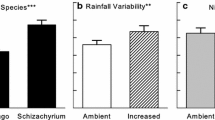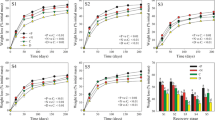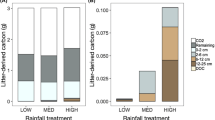Abstract
Precipitation is a key driver of litter decomposition in arid/semiarid regions; where soils are poor in organic matter, and thus re-incorporation of litter is key for soil nutrient accumulation and soil structure. It remains unclear, though, whether litter decomposition responds symmetrically to precipitation variation (e.g., if precipitation surpluses produce a stimulatory effect of a similar magnitude, but opposite direction to inhibitory effects of precipitation deficits), and whether litter decomposition and litter nutrient dynamics in arid and semiarid ecosystems that differ in climate show similar responses to precipitation. We set up a 5-and-a-half-year experiment that manipulated rainfall along a gradient (7 treatments): increases by 20%, 40%, and 60%, background precipitation, and reductions by the same 3 percentages. We applied such experiment in two sites with different pattens of precipitation (Urat: arid; and Naiman: semiarid) in Inner Mongolia to elucidate our questions. Litter mass loss and all nutrients that we measured (carbon, nitrogen, phosphorous, potassium, plus lignin) decomposed faster at the highest level of surplus precipitation, and more slowly in the two largest precipitation reductions. This indicates that these levels of precipitation constitute thresholds (value of precipitation beyond which ecosystem function is critically altered). Litter decomposition in the semiarid site was faster and more complete, but decomposition in the direr Urat was more efficient per unit cumulative rainfall. Thus, site specific effects played an important role in decomposition. Reductions in precipitation decreased the loss of C, N, P, K, and lignin from litter; and clear precipitation thresholds in the dynamic of these nutrients in litter were observed. Overall, this indicated the importance of precipitation limitation at controlling nutrient release. Our study highlights the importance of long-term studies on litter decomposition in environments with slow decomposition rates, and the importance of taking into account mechanistic effects of water availability on decomposition.




Similar content being viewed by others
Change history
19 December 2023
A Correction to this paper has been published: https://doi.org/10.1007/s00374-023-01785-7
References
Adair EC, Parton WJ, Grosso SJD, Silver WL, Harmon ME, Hall SA, Burke IC, Hart SC (2008) Simple three - pool model accurately describes patterns of long - term litter decomposition in diverse climates. Glob Chang Biol 14:2636–2660
Anaya CA, Jaramillo VJ, Martinez-Yrizar A, Garcia-Oliva F (2012) Large rainfall pulses control litter decomposition in a tropical dry forest: evidence from an 8-year study. Ecosystems 15:652–663
Bao SD (2000) Soil agrochemical analysis. China Agriculture Press, Beijing, pp 22–103
Berg B, Laskowski R (2005) Nitrogen dynamics in decomposing litter. Adv Ecol Res 38:157–183
Bloor JMG, Bardgett RD (2012) Stability of above-ground and below-ground processes to extreme drought in model grassland ecosystems: interactions with plant species diversity and soil nitrogen availability. Perspect Plant Ecol Evol Syst 14:193–204
Bosatta E, Agren GI (1985) theoretical-analysis of decomposition of heterogeneous substrates. Soil Biol Biochem 17:601–610
Brandt LA, King JY, Milchunas DG (2007) Effects of ultraviolet radiation on litter decomposition depend on precipitation and litter chemistry in a shortgrass steppe ecosystem. Glob Chang Biol 13:2193–2205
Couteaux MM, Berg B, Bottner P (1995) Litter decomposition, climate and litter quality. Trends Ecol Evol 10:63–66
Du N, Li W, Qiu L, Zhang Y, Wei X, Zhang X (2020) Mass loss and nutrient release during the decomposition of sixteen types of plant litter with contrasting quality under three precipitation regimes. Ecol Evol 10:3367–3382
Easterling DR, Meehl GA, Parmesan C, Changnon SA, Karl TR, Mearns LO (2000) Climate extremes: observations, modeling, and impacts. Science 289:2068–2074
Gliksman D, Rey A, Seligmann R, Dumbur R, Sperling O, Navon Y, Haenel S, De Angelis P, Arnone JA, Gruenzweig JM (2017) Biotic degradation at night, abiotic degradation at day: positive feedbacks on litter decomposition in drylands. Glob Chang Biol 23:1564–1574
Gong J, Zhang Z, Zhu C, Shi J, Zhang W, Song L, Li Y, Zhang S, Dong J, Li X (2022) The response of litter decomposition to phosphorus addition in typical temperate grassland in Inner Mongolia. J Arid Environ 197:104677
Gong J, Zhu C, Yang L, Yang B, Wang B, Baoyin T, Liu M, Zhang Z, Shi J (2020) Effects of nitrogen addition on above-and belowground litter decomposition and nutrient dynamics in the litter-soil continuum in the temperate steppe of Inner Mongolia, China. J Arid Environ 172:104036
Hoover DL, Wilcox KR, Young KE (2018) Experimental droughts with rainout shelters: a methodological review. Ecosphere 9:e02088
Huang G, Li Y (2017) Photodegradation effects are related to precipitation amount, precipitation frequency and litter traits in a desert ecosystem. Soil Biol Biochem 115:383–392
Huang J, Yu H, Guan X, Wang G, Guo R (2016) Accelerated dryland expansion under climate change. Nat Clim Chang 6:166–171
IPCC. Climate Change (2014) Synthesis Report. Contribution of Working Groups I, II and III to the Fifth Assessment. In: Report of the Intergovernmental Panel on Climate Change, Geneva, Switzerland
Jin VL, Haney RL, Fay PA, Polley HW (2013) Soil type and moisture regime control microbial C and N mineralization in grassland soils more than atmospheric CO2-induced changes in litter quality. Soil Biol Biochem 58:172–180
Joseph G, Henry HAL (2008) Soil nitrogen leaching losses in response to freeze-thaw cycles and pulsed warming in a temperate old field. Soil Biol Biochem 40:1947–1953
Kemp PR, Reynolds JF, Virginia RA, Whitford WG (2003) Decomposition of leaf and root litter of Chihuahuan desert shrubs: effects of three years of summer drought. J Arid Environ 53:21–39
Ladwig LM, Collins SL, Swann AL, Xia Y, Allen MF, Allen EB (2012) Above- and belowground responses to nitrogen addition in a Chihuahuan Desert grassland. Oecologia 169:177–185
Lecerf A (2021) The construction of plant litter decomposition curves. In: Swan CM, Boyero L, Canhoto C (eds) The ecology of plant litter decomposition in stream ecosystems. Springer Nature, New York, pp 433–453
Li YL, Ning ZY, Cui D, Mao W, Bi JD, Zhao XY (2016) Litter decomposition in a semiarid dune grassland: neutral effect of water supply and inhibitory effect of nitrogen addition. PLoS One 11:e0162663
Li Z, Peng Q, Dong Y, Guo Y (2022) The influence of increased precipitation and nitrogen deposition on the litter decomposition and soil microbial community structure in a semiarid grassland. Sci Total Environ 844:157115
Liu C, Liu Y, Guo K, Wang S, Yang Y (2014) Concentrations and resorption patterns of 13 nutrients in different plant functional types in the karst region of south-western China. Ann Bot 113:873–885
Liu P, Huang J, Han X, Sun OJ (2009) Litter decomposition in semiarid grassland of Inner Mongolia, China. Rangel Ecol Manag 62:305–313
Liu P, Huang J, Han X, Sun OJ, Zhou Z (2006) Differential responses of litter decomposition to increased soil nutrients and water between two contrasting grassland plant species of Inner Mongolia, China. Appl Soil Ecol 34:266–275
Mahmood H, Limon SH, Rahman MS, Azad AK, Islam MS, Khairuzzaman M (2009) Nutrients (N, P and K) dynamics associated with the leaf litter of two agroforestry tree species of Bangladesh. IForest 2:183–186
Manzoni S, Trofymow JA, Jackson RB, Porporato A (2010) Stoichiometric controls on carbon, nitrogen, and phosphorus dynamics in decomposing litter. Ecol Monogr 80:89–106
Medina-Roldán E, Huber-Sannwald E, Arredondo JT (2013) Plant phenotypic functional composition effects on soil processes in a semiarid grassland. Soil Biol Biochem 66:1–9
Meehl GA, Stocker TF, Collins WD, Friedlingstein P, Gaye AT, Gregory JM, Kitoh A, Knutti R, Murphy JM, Noda A, Raper SC (2007) Global climate projections. In: Solomon S, Qin D, Manning M, Chen Z, Marquis M, Averyt KB, Tignor M, Miller HL (eds) Climate change 2007: The Physical Science Basis. Cambridge University Press, New York, pp 747–845
Moorhead DL, Reynolds JF (1991) A general-model of litter decomposition in the Northern Chihuahuan desert. Ecol Modell 56:197–219
Muggeo VMR (2008) Segmented: an R Package to fit regression models with broken-line relationships. R news 8:20–25
Olson J (1963) Energy storage and the balance of producers and decomposers in ecological systems. Ecology 44:322–331
Osono T, Takeda H (2004) Potassium, calcium, and magnesium dynamics during litter decomposition in a cool temperate forest. J For Res 9:23–31
Pinheiro J, Bates D, R Core Team (2022). nlme: linear and nonlinear mixed effects models. R package version 3.1-159 http://cran. r-project. org/web/packages/nlme/
Qu H, Zhao HL, Zhao XY, Zuo XA, Wang SK, Chen M (2017) Effects of sand burial on the survival and growth of two shrubs dominant in different habitats of northern China. Environ Monit Assess 189:149
Qu H, Zhao X, Wang S, Lian J, Tang X, Wang X, Zhang R, Medina-Roldan E (2021) Abiotic factors affect leaf litter mass loss more strongly than initial litter traits under sand burial conditions. Catena 196:104900
Qu H, Zhao XY, Lian J, Tang X, Wang XY, Medina-Roldan E (2020) Increasing precipitation interval has more impacts on litter mass loss than decreasing precipitation amount in desert steppe. Front Environ Sci 8:88
R Core Team (2022) R: A language and environment for statistical computing. R Foundation for Statistical Computing, Vienna, Austria https://www.R-project.org/
Rutigliano FA, De Santo AV, Berg B, Alfani A, Fioretto A (1996) Lignin decomposition in decaying leaves of Fagus sylvatica L. and needles of Abies alba Mill. Soil Biol Biochem 28:101–106
Salamanca EF, Kaneko N, Katagiri S (2003) Rainfall manipulation effects on litter decomposition and the microbial biomass of the forest floor. Appl Soil Ecol 22:271–281
Sanders J (2008). Veusz-a scientific plotting package. https://veusz.github.io/ [Last accessed 20 July 2022]
Sardans J, Penuelas J (2005) Drought decreases soil enzyme activity in a Mediterranean Quercus ilex L. forest. Soil Biol Biochem 37:455–461
Sardans J, Penuelas J, Estiarte M (2007) Seasonal patterns of root-surface phosphatase activities in a Mediterranean shrubland. Responses to experimental warming and drought. Biol Fertil Soils 43:779–786
Schwinning S, Sala OE, Loik ME, Ehleringer JR (2004) Thresholds, memory, and seasonality: understanding pulse dynamics in arid/semi-arid ecosystems. Oecologia 141:191–193
Spohn M, Berg B (2023) Import and release of nutrients during the first five years of plant litter decomposition. Soil Biol Biochem 176:108878
Suseela V, Tharayil N (2018) Decoupling the direct and indirect effects of climate on plant litter decomposition: accounting for stress-induced modifications in plant chemistry. Glob Chang Biol 24:1428–1451
Throop HL, Archer SR (2009) Resolving the dryland decomposition conundrum: some new perspectives on potential drivers. Prog Bot 70:171–190
Throop HL, Belnap J (2019) Connectivity Dynamics in dryland litter cycles: moving decomposition beyond spatial stasis. Bioscience 69:602–614
Wang S, Zuo X, Awada T, Medima-Roldan E, Feng K, Yue P, Lian J, Zhao S, Cheng H (2021) Changes of soil bacterial and fungal community structure along a natural aridity gradient in desert grassland ecosystems. Inner Mongolia. Catena 205:105470
Wang X, Xu Z, Lu X, Wang R, Cai J, Yang S, Li M, Jiang Y (2017) Responses of litter decomposition and nutrient release rate to water and nitrogen addition differed among three plant species dominated in a semi-arid grassland. Plant Soil 418:241–253
Wang Y, Gong J, Liu M, Luo Q, Xu S, Pan Y, Zhai Z (2015) Effects of land use and precipitation on above- and below-ground litter decomposition in a semi-arid temperate steppe in Inner Mongolia, China. Appl Soil Ecol 96:183–191
Wen SH, Tian YQ, Ouyang SN, Song MH, Li XB, Zhang Y, Gao S, Xu XL, Kuzyakov Y (2022) High frequency of extreme precipitation increases Stipa grandis biomass by altering plant and microbial nitrogen acquisition. Biol Fertil Soils 58:63–75
Yahdjian L, Sala OE (2006) Vegetation structure constrains primary production response to water availability in the Patagonian steppe. Ecology 87:952–962
Yang DC, Hu L, Song XY, Wang CT (2021b) Effects of changing precipitation on litter quality and decomposition of different plant functional groups in an Alpine meadow. Chin JPlant Ecol 45:1314 (in Chinese)
Yang G, Yu SY, Zhang X, Pei ZY, Zheng WS, Li H (2021a) Geographical distribution simulation of Caragana microphylla in the North Temperate Zone. Grassland and Turf 41:8–17 (in Chinese)
Yang H, Li Y, Zhan J, Bao C, Luo Y (2022) Effects of litter chemical traits and species richness on soil carbon cycling changed over time. Front Environ Sci 10:2240
Yang Y, Liu B (2019) Effects of planting Caragana shrubs on soil nutrients and stoichiometries in desert steppe of Northwest China. Catena 183:104213
Zhang B, Wang H, Yao S, Bi L (2013) Litter quantity confers soil functional resilience through mediating soil biophysical habitat and microbial community structure on an eroded bare land restored with mono Pinus massoniana. Soil Biol Biochem 57:556–567
Zhang R, Zhao X, Zuo X, Qu H, Degen AA, Luo Y, Ma X, Chen M, Liu L, Chen J (2019) Impacts of precipitation on ecosystem carbon fluxes in desert-grasslands in Inner Mongolia, China. J Geophys Res Atmos 124:1266–1276
Zhang X, Mao R, Gong C, Qiao T, Song C (2014) CO2 evolution from standing litter of the emergent macrophyte Deyeuxia angustifolia in the Sanjiang Plain, Northeast China. Ecol Eng 63:45–49
Acknowledgements
We thank all the members of Urat Desert-grassland Research Station and Naiman Desertification Research Station, Chinese Academy of Sciences, for their contributions in laboratory and field work. This work was supported by the National Natural Science Foundation of China (42377473, 41877540). We are also thankful for the comments of the anonymous Reviewers that helped us to improve the manuscript.
Author information
Authors and Affiliations
Corresponding author
Ethics declarations
Conflict of interest
The authors declare no competing interests.
Additional information
Publisher’s note
Springer Nature remains neutral with regard to jurisdictional claims in published maps and institutional affiliations.
The original online version of this article was revised due to a retrospective Open Access cancellation.
Supplementary information
ESM 1
(DOC 20.9 MB)
Rights and permissions
Springer Nature or its licensor (e.g. a society or other partner) holds exclusive rights to this article under a publishing agreement with the author(s) or other rightsholder(s); author self-archiving of the accepted manuscript version of this article is solely governed by the terms of such publishing agreement and applicable law.
About this article
Cite this article
Qu, H., Medina-Roldán, E., Wang, S. et al. A 5-and a-half-year-experiment shows precipitation thresholds in litter decomposition and nutrient dynamics in arid and semi-arid regions. Biol Fertil Soils 60, 199–212 (2024). https://doi.org/10.1007/s00374-023-01779-5
Received:
Revised:
Accepted:
Published:
Issue Date:
DOI: https://doi.org/10.1007/s00374-023-01779-5




